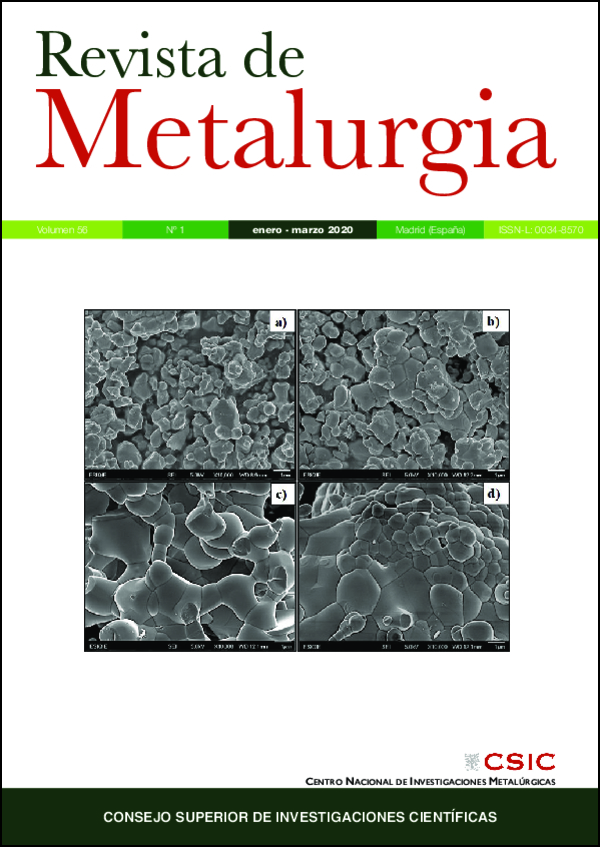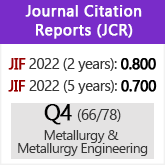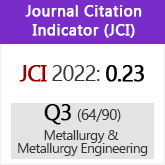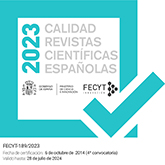Influence of samples location and orientation on hot-rolled structural steel mechanical properties: Experimental report
DOI:
https://doi.org/10.3989/revmetalm.162Keywords:
Mechanical testing, Plastic deformation, Standard, Structural steel, Tensile propertiesAbstract
For an accurate modelling of structures behavior, a precise determination of mechanical properties of structural steel is essential. Mechanical characterization must achieve standard prescriptions; thus, samples must be taken from a specific location and orientation, and the obtained properties from these specimens are used to characterize, uniquely, the steel. The hot-rolling process of structural steel profiles manufacture, which induces residual stresses distribution, can affects to homogeneity and isotropy of final product, therefore, uniformity of mechanical properties along the section is not guaranteed. The variation of these properties depending on orientation and location is studied in this paper. A tensile testing experimental program, where stress – strain curves are recorded and used to obtain mechanical properties at elastic and plastic conditions from different locations and orientations, have been carried out. No similar experimental work was found at literature, except in case of cold-bending formed steel. Results showed no significant differences for most cases, however properties related with necking and failure showed a clear dependence on location. Higher differences were found at specimens from the center of the flange. In addition, the research performed denotes that orientation has no influence on the variation of mechanical properties of hot-rolled steel.
Downloads
References
ASTM A370-16 (2016). Standard test methods and definitions for mechanical testing of steel products. Conshohocken, Pennsylvania, California, USA. https://www.astm.org/DATABASE.CART/HISTORICAL/A370-16.htm.
Coelho, A.M.G., Da Silva, L.S., Bijlaard, F.S.K. (2004). Characterization of the nonlinear behaviour of single bolted T-Stub connections. Proceeding of Connections in Steel Structures V, Amsterdam, Netherlands, pp. 53-64. https://www.steel.org.au/resources/elibrary/library-items/characterization-of-the-nonlinear-behaviour-of-sin/.
EN 10025-2 (2004). CEN/ECISS/TC103: Hot rolled products of structural steels - Part 2: Technical delivery conditions for non-alloy structural steels. European Committee for Standardization. Brussels, Belgium. https://standards.cen.eu/dyn/www/f?p=204:110:0::::FSP_PROJECT,FSP_ORG_ID:19742,734438&cs=19ED055BD7D76C04289651731E88EAB05.
EN 1993-1-1 (2005). CEN/TC 250, Eurocode 3: Design of steel structures - General rules and rules for building. European Committee for Standardization. Brussels, Belgium. https://standards.cen.eu/dyn/www/f?p=204:110:0::::FSP_PROJECT:12454&cs=11B4D194E5706FD8900424D5E375E9801.
Gioncu, V., Mazzolani, F. (2002). Ductility of Seismic-resistant Steel Structures. CRC Press, United Kingdom. https://www.crcpress.com/Ductility-of-Seismic-Resistant-Steel-Structures/Gioncu-Mazzolani/p/book/9780419225508. https://doi.org/10.1201/9781482271904
ISO 14284 (1996). ISO/TC17/SC1, Steel and iron: Sampling and preparation of samples for the determination of chemical composition. International Organization for Standardization, Switzerland. http://www.iso.org/iso/catalogue_detail.htm?csnumber=24063.
ISO 6892-1 (2016). ISO/TC164/SC1, Metallic materials - Tensile testing - Part 1: Method of test at room temperature. International Organization for Standardization, Switzerland. https://www.iso.org/standard/61856.html.
ISO 377 (2017). ISO/TC17/SC20, Steel and steel products - Location and preparation of samples and test pieces for mechanical testing. International Organization for Standardization, Switzerland. https://www.iso.org/standard/ 72529.html.
Kato, B., Aoki, H., Yamanouchi, H. (1990). Standardized mathematical expression for stress-strain relations of structural steel under monotonic and uniaxial tension loading. Mater. Struct. 23, 47-58. https://doi.org/10.1007/BF02472997
Lenard, J.G., Pietrzyk, M., Cser, L. (1999). Chapter 6 - Microstructure Evolution and Mechanical Properties of the Final Product. In: Mathematical and Physical Simulation of the Properties of Hot Rolled Products Elsevier Science, pp. 151-236. https://doi.org/10.1016/B978-008042701-0/50006-1
Llewellyn, D.T., Hudd, R.C. (1998). Low-carbon structural steels. In: Steels: Metallurgy and applications. Chapter 2, Hudd DTLC (Ed), Butterworth-Heinemann, Oxford, pp. 137-198. https://doi.org/10.1016/B978-075063757-2/50002-0
Nadai, A. (1933). Theories of Strength. J. Appl. Mech. 1, 111-129.
Piluso, V., Faella, C, Rizzano, G. (2001). Ultimate behavior of bolted T-Stubs. I: Theoretical model. J. Struct. Eng - ASCE 127 (6), 686-693. https://doi.org/10.1061/(ASCE)0733-9445(2001)127:6(686)
RILEM (1990). Tension testing of metallic structural materials for determining stress-strain relations under monotonic and uniaxial tensile loading. RILEM Draft Recommendation, Mater. Struct. 23, 35-46. https://doi.org/10.1007/BF02472996
Spoorenberg, R.C., Snijder, H.H., Hoenderkamp, J.C.D. (2012) Mechanical properties of roller bent wide flange sections - Part 1: Experimental investigation. J. Constr. Steel Res. 68 (1), 51-62. https://doi.org/10.1016/j.jcsr.2011.07.003
Zhao, Y., Weng, Y., Peng, N., Tang, G.B., Liu, Z.D. (2013). Prediction of Mechanical Properties of Hot Rolled Strip by Using Semi-Parametric Single-Index Model. J. Iron Steel Res. Int. 20, 9-15. https://doi.org/10.1016/S1006-706X(13)60119-3
Published
How to Cite
Issue
Section
License
Copyright (c) 2020 Consejo Superior de Investigaciones Científicas (CSIC)

This work is licensed under a Creative Commons Attribution 4.0 International License.
© CSIC. Manuscripts published in both the printed and online versions of this Journal are the property of Consejo Superior de Investigaciones Científicas, and quoting this source is a requirement for any partial or full reproduction.All contents of this electronic edition, except where otherwise noted, are distributed under a “Creative Commons Attribution 4.0 International” (CC BY 4.0) License. You may read here the basic information and the legal text of the license. The indication of the CC BY 4.0 License must be expressly stated in this way when necessary.
Self-archiving in repositories, personal webpages or similar, of any version other than the published by the Editor, is not allowed.


















